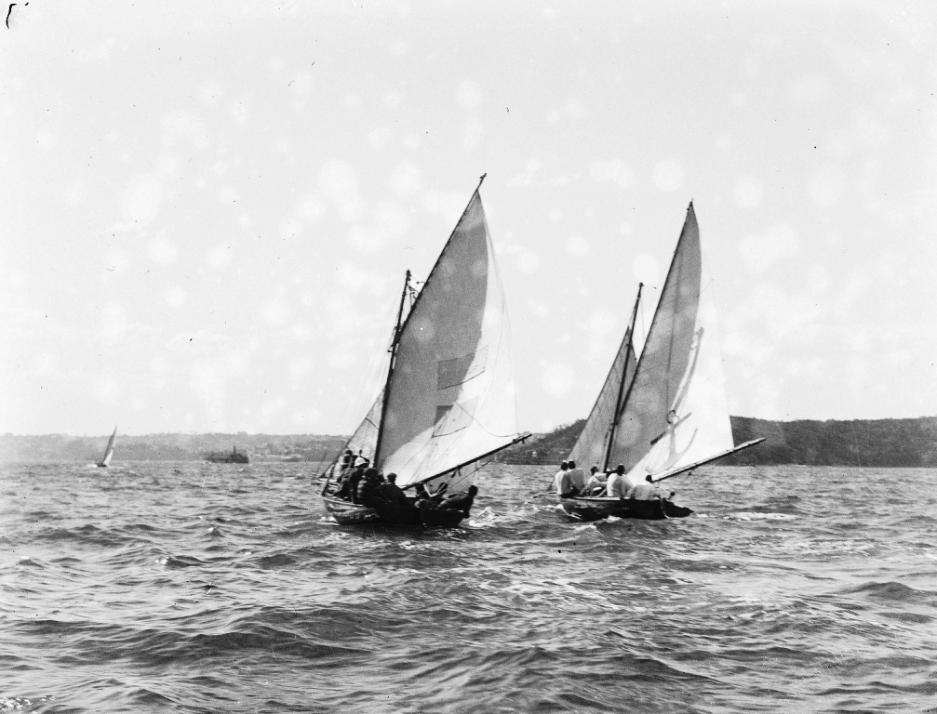May 25 - 31, 2014: Issue 164
Port Jackson Pleasure Fleets – 3 and 424-footers, the Advent of Sailing Schnapper Boats in Races to and from Barrenjoey
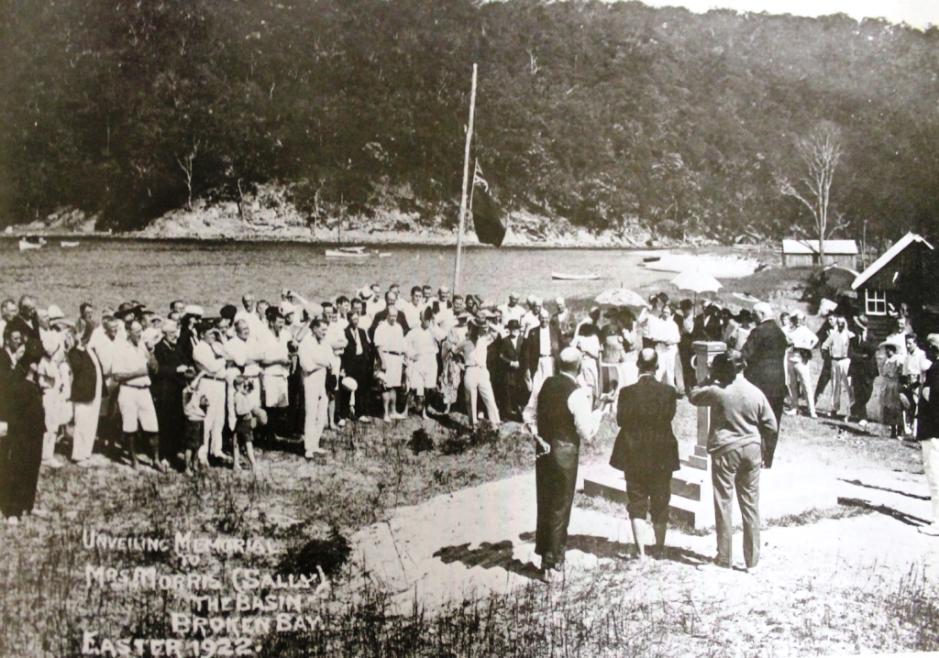
Unveiling Memorial to Mrs. Morris (Sally) - The Basin, Broken Bay - Easter 1922.
Port Jackson Pleasure Fleets – 3 and 424-footers, the Advent of Sailing Schnapper Boats in Races to and from Barrenjoey
No – 3.
Stir the Viking's blood,
Bracing blood and sinew,
Blow, thou wind of God! —
Charles Kingsley.
The appearance of the yachts in the old days differed from that of our present day cracks. Black hulls, gold bands, plumb stems, and comparatively short counters were almost general; The Xarifa, which was no beauty, had rather a somewhat curved stem, the Ella's stuck-out, ram-like, the Pert's was like that of a ketch, and the Australian's bow in profile was the nearest approach to a modern yacht's. The Chance had the schooner's orthodox cut-water. The gaff-topsail, which is seldom seen nowadays, replaced the jib header when racing, and squaresails and raffees made a brave show on the run. The Oithana, it is claimed, carried the first spinnaker in this port. In spite of all modern improvements, the appearance of the boats was better in those days; at any rate a little way off. White scrubbed decks, and varnished teak deck fittings look better than the painted decks and painted cabin tops of the present-day, and it must be confessed that the mixing of white paint for yachts sides is not generally understood, even among our best builders. In fact, you seldom see a decent coat of white paint on a boats side.
SLOVENLY OWNERS
Several present-day owners are notoriously slovenly in their turns-out; their sails are mildewed, their spars never scraped, their top sides shabby while, to use the words of an old sailing-man, “Their, cabins look as if they had been struck by lightning, and the smell of their bilges would stink a hungry dog out of a tan yard.” There can be no excuse for such owners; they spoil the look of the harbor; they bring discredit to yachting, and they give the place a bad name. “If that is how they keep their yachts,” said a visitor, “what must their homes be like?”
It is a pleasure to turn away from those slovenly-kept yachts (it is fair to say that they are but few), and remember the way such men as Dick Hellings, Sam Richardson, Wrixon, and the Millers used to turn out their vessels.
RACING IN THE SEVENTIES.
The beautiful Mistral (34 tons), Mr. .H. C. Dangar, was built in 1868 by Dan Sheehy from English designs, and proved worthy of the Xarifa's steel; they each had their successes till the old champion was sold to King Thackembau and sailed for Fiji. The writer heard of her only once again, and that was in connection with a voyage of hers when she brought from Samoa to Fiji a number of beautiful Samoan girls. Some few years after the departure of the Xarifa, the Nereid, which had been built in the sixties by Langford from his own designs, for Messrs Lassetter and Fairfax and had won nearly a score of races, gave place to the Magic (28 tons) and the Mistral which had been left without a rival of her own class, found a too formidable one in the new yacht. After a close and exciting first race, the Magic won by a few seconds in point of place, though, if the time for tonnage were taken into consideration the Magic's victory was more substantial. Many races between these two yachts followed, the Magic generally having the best of the deal. Mr Jack Newton imported the Secret from New Zealand about 1877, and the Waitangi some time afterwards, but they gave the Magic no serious trouble, and the English designed Oithona was hardly big enough to compete satisfactorily with her. Mr. Fred Jackson, who is now the doyen of Sydney yachting and has been a consistent and successful yacht owner since his youth, caused a revolution in the second class by bringing out, in 1878*, the Violet, built by Langford from designs by Hatcher. She simply carried everything before her, and from her appearance dates the downfall of the purely local designers.
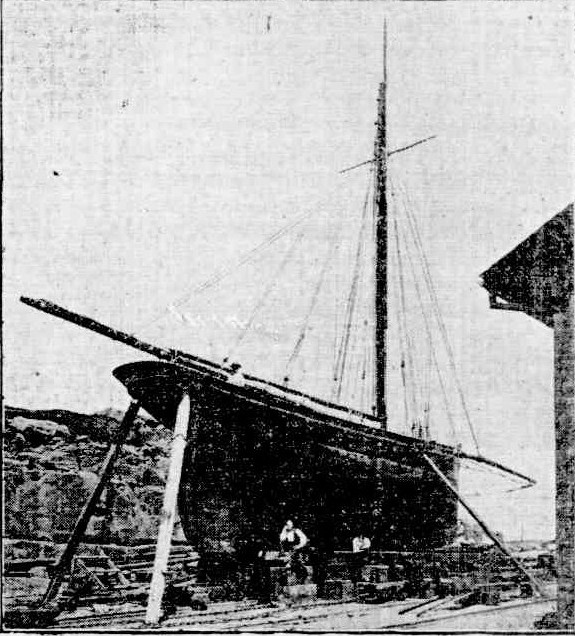
The Magic.
THE BOHEMIAN BOATING.
It was in these boats that the Bohemians of boating were to be found. On board the Kingfisher, the Sea-Breeze, the Coryphene, the Wyvern, the Sylvia, and others of the class, you met a lot of pleasant, jovial, reckless, young fellows, who formed a delightful camaraderie of their own. Burnt brown by the sun, their faces roughened by exposure to the weather, barefooted, careless in their attire, they gave no indication of the social position their parents occupied. They ran their boats harder than the yachts were run; they loved the open sea, and many a fight with the elements was won only through their skill, pluck, and determination. Broken Bay, Botany, and Port Hacking were their favorite resorts.
Sometimes they flung a fly over the boom, drew a canful of dry hopped colonial beer from their keg, and having made a table of a couple of side benches, sat down happy and contented to a meal cooked on a 'spunkie' stove, or oftener a fire-pot made of a nail-can. They pitied the yachtsman faring sumptuously in their cabins, and they would not have exchanged places with them even if the yachts had been thrown in. This may seem an exaggeration, but it is not, and the writer remembers the efforts of a father who tried in vain to wean his son from his fascination for fishing boats by offering him a 10-tonner designed by Hatcher. When the party was large, a tent was pitched on shore, and many a pleasant, evening was spent under the she-oaks through which the zephyrs sang as through an aeolian harp. The grills sizzled on the glowing embers of a gumstick fire and appetites, whetted by the open air, more than made up for the plainness of the fare. After the evening meal they heaped the fragrant fuel on the fire, and gathering round, told stories and sang songs with rollicking choruses. Fish and game were more plentiful in those days, and some of the parties used to do a good deal of shooting and fishing; others were too lazy, and lay on the white beaches basking in the sunshine, after their frequent baths in the clear crystal-like water, or, when the weather grew too warm, sought some cool sassafras gully, where the water trickled over the moss-grown rocks.
THE EXOTIC.
It is strange how some young fellows from England took to this particular form of pleasure. One exotic, for at first, he looked one among his rough and weather-beaten companions made his appearance on board one of the boats; his experiences in yachting at home had been on board the class of yachts that carry a French chef, and Solomon in all his glory could not have been more unsuitably garbed for a cruise in a fishing boat. Before that cruise was over his own mother would not have known him. His pretty English complexion had gone, his refined features were swollen by mosquito bites, his nose was red as the night-cap which had repaired the loss of a well-cut tweed cap, his eyes were like burnt holes in a blanket and his arms, feet, and back were scorched by the sun. Yet he had become an enthusiast, and some readers will recall with pleasure his delightful tenor, which was a decided acquisition at the sing-songs in those days. But were there no Mimis and Musettes in this boating Bohemia? it may be asked. As a rule, the fellows were not ladies men but it is on record that a hairpin was found on board one of their boats. To go back to the boats themselves, their sides were generally painted white, with a blue top streak and a coat of Lane Cove varnish (i.e.: tar) under the waterline. Their cruising sails were often tan; but whewn they raced they came out in the their glory of their big white sails. “What she can’t cay she’ll have to drag,” was the spirit in which they were sailed, and often enough their crews were left swimming while their boats reposed at the bottom of the harbour.
“I wonder,” said a girl to an old waterman, “the sharks don’t take them.”
“Now, if you was a respectable shark, would you?” was the quick retort.
It may be mentioned that the Kingfisher capsized and sank between Bradley's and George's Heads on December 25, 1873, and that on the following day, with Mr. Bransby at the helm, she finished second in the race for fishing-boats under canvas. Of course, Jack Want had to be in the fun, and, although he had, so to speak, been born to yachts, he could not resist the fascination of the fishing-boat. When the Sea Breeze in her turn capsized in a race, he plucked the racing colours off her peak as she was sinking with the characteristic remark, “We'll save these, anyway!”
The Quartier Latin is no longer the Quartier Latin novelists are never tired of telling us. Our Bohemia of boating has disappeared, and, though we regret the boats, it must be admitted it that in some respects it is, perhaps just as well that it has, for the cruises, on the particular lines on which they were run, ill-fitted some fellows for their studies or their work. They failed. Those on the other hand, who possessed the faculty of putting the stop in at the right time, became so respectable as to be trusted to take round the church plate, and though, as we have seen, they were not ladies' men in their younger days, when the lines of a fishing-boat filled their eyes better than the outlines of any statuary, those who married were to be congratulated on their excellent taste and good fortune.
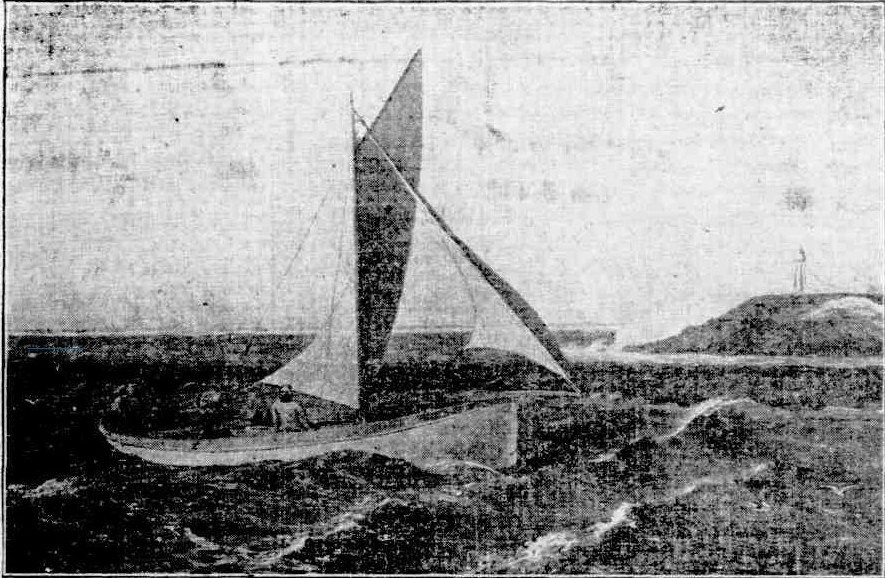
The Sea Breeze.
This race was sailed on Saturday, January 31, 1874. Both parties were, as usual, confident of success and eager for the trial. The course was from the lightship off Sow and Pigs, round a boat moored off Barrenjoey and back. The umpire, Mr. W. O. Gilchrist started the boats at 10.15 a.m. The Kingfisher at once went to the front, and was 50 yards ahead at South Reef. She passed North Head at 10.30 a.m. The wind was from the E.S.EO and the Kingfisher set her spinnaker while the Sea Breeze set a square sail and a water sail. The Kingfisher subsequently set a square sail. In the meantime the boats made good way up the coast. Long Reef had been passed at 11.12 by the Kingfisher, some four minutes ahead of her rival, which was losing ground, and the flag boat was rounded by the Kingfisher with a strong lead. On the beat back the Sea Breeze, which carried a sprit mainsail, while the Kingfisher staggered under a larger mainsail with a gaff, pointed higher, and at 2.30 she was quite half a mile to windward. The breeze had been steadily increasing, and the boats met with a lumpy, confused sea, in which the Kingfisher, with her heavy spars and big sails, fared badly. Her crew however, persevered steadily on till Long Reef, when, finding the task they had set themselves impossible under their rig, they ran for shelter to Broken Bay. The crew of the Sea Breeze, drenched and shivering, managed to bring their boat home safely, and she passed the lightship a winner at 5. 38 p.m. The Magic, then a new boat the Alick, and the Peri (an old opponent of the Xarifa) followed the race. The Magic carried away her bobstay and the two other yachts thoroughly drenched their crew in the confused seas. There was some correspondence in the newspapers of the time about the inadvisableness of racing open boats over an outside course, but the Kingfisher was shortly afterwards at it again, and she lowered the colours of the Sea Spray on the same course in a stiff westerly.
(To Be Continued)
The Magic.
The Sea Breeze.
PORT JACKSON'S PLEASURE FLEETS. (1907, October 26).Evening News (Sydney, NSW : 1869 - 1931), p. 3. Retrieved fromhttp://nla.gov.au/nla.news-article113896201
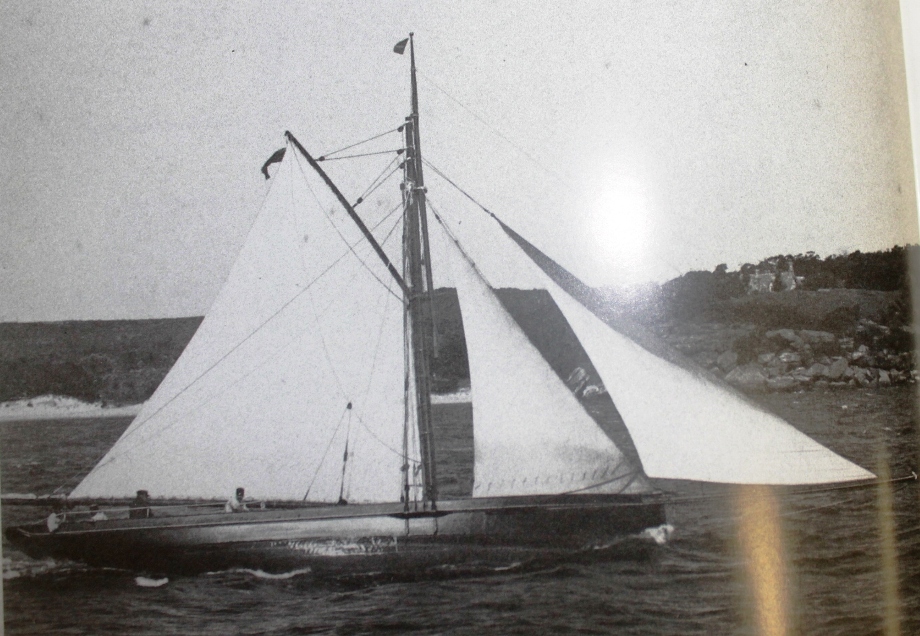
PORT JACKSON'S PLEASURE FLEETSDESCRIPTION OF A RACE BY JACK WANT.NO. - 4; BY LANYARD.
“The wind is fresh, the wind is foul;The clouds are long, and low, and grey;
The rocky headland wears a cowl.
And looks a monk who kneels to pray.”
—Day.
Through the courtesy of Mr. Thomas Marshall, Commodore of the P.A.Y.C., the writer is enabled to give the following account,written by the late Mr. John Want, of an open boat race in 1878.
At 2 p.m. in the middle of a black northeaster, Coryphene, Sea Breeze, and Wyvern put in an appearance, followed shortly by the Kingfisher and Sylvia, for a race round a boat off Manly Beach and back for a sweepstakes of £5 a boat. Their stations having been allotted to them, they took up their moorings accordingly:— Coryphene, No. 1, close reefed; Sea Breeze, 2, with 2 reefs down; Sylvia 3, with 2 reefs down; Kingfisher 4, close reefed; Wyvern 5, close reefed. No. 1 being nearest to Farm Cove, and No. 5, a few yards from the red buoy, and to windward of it. At about 3 p.m., Mr. Amora, who acted as umpire and starter, lowered his flag, and all five were off like smoke, -all on the starboard tack. Montgomery, in the Coryphene, being to leeward and astern of Sea Breeze without any right or reason, put his helm down and came stem on to Sea Breeze, causing serious damage and some nasty cuts, the long bumpkin coming clean on over the tuck into the boat, and fouling everything, sent the Breeze right up into the wind in irons, while Coryphene, being pushed off to get her clear, got the benefit of a long start, before Sam Richardson, who was piloting the Sea Breeze, could get his boat on her legs again. Should the Sea Breeze have arrived second, she could clearly have claimed the prize. Mr. Want, the owner of Coryphene, was as much disgusted as anyone.
While this fouling was going on, Kingfisher, with Newton at the helm, Sylvia with Ellis, and Wyvern with Colebrook, were pegging along right merrily for the northern shore, getting out of the wind and sea, while Coryphene and Sea Breeze, through the foul, were forced to stand away all through the worst of the tide rip and wind to leeward of Fort Denison, a straight on end stretch down the harbor. Coryphene making splendid weather of it, and as snug as possible, Sea Breeze, like a log, smothered with canvas, her full bows making terrific gaps in the huge rollers, and taking in water enough to satisfy the veriest teetotaller. Buckets and bailers were soon in requisition on all Sides. Coryphene passed Garden Island as Sea Breeze passed Fort Denison, both to leeward of the latter, Wyvern looking very dangerous. Well to the windward of the fort, and abreast of Sea Breeze, Kingfisher and Sylvia stall closer to the North Shore.
At this point of the race the sailing was very grand; each boat looked like a newly-arrived Immigrant Ship, some having as many as sixteen sitters, all perched out on the weather gunwale, main-sheets and jib-sheets working like steam cranes. And the stinging black puffs came down one after another, knocking up a terrific sea, blowing the spray about and over everything; making the water look as if a feather bed manufacturory had broken loose. It did blow, and no mistake, until they reached Bradley’s when it seemed to lull a little, and things became more settled. Wyvern went about at Bradley’s, weathered the short-reef; and looked like crossing Corryphene, who had waited longer on her port tack, going about between Shark Island and Bradley’s. Richardson stood right in to near Shark Point and made a great pull on both leading boats. Kingfisher and Sylvia making a still larger luff; but evidently out of the race, neither of them sailing up to the mark, and both making very bad weather. There was some baling done, I can tell you, nothing but buckets would satisfy our requirements, and an occasional deep-sea fishing trip left the boats with water up to the thwarts, and a long luff and all hands at the buckets was more common than extraordinary.
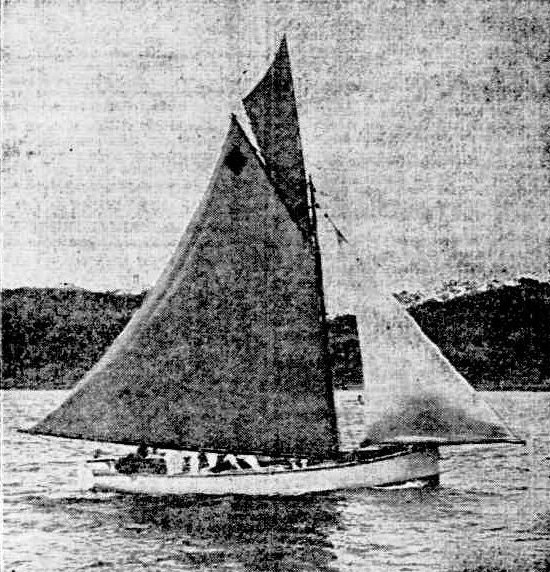
The Adelphi (Coryphene's Sister).
Coryphene rounded the buoy first, and shook out a reef, while Wyvern, having worked short tacks, came next just as the former boat ran past little Manly Head, over 300 yards in front. Sea Breeze rounded next, only about five yards astern. Kingfisher made No. 4, about three-quarters of a mile astern, and Sylvia about the same distance behind the old fisher. Coryphene, after taking a long time to think about it, set a balloon jib as a spinnaker, the others all sending up square sails smartly came home rolling and racing, like mad things. Such a breeze as they had behind them it is a wonder they were not blown clean out of the water, Coryphene, barring accidents, having the first prize on board, while Sea Breeze and Wyvern were making a desperate race for second place. The former, being a little ahead, finding it was getting rather hot, foolishly hoisted a big topsail. This sent her ahead a little but she eventually paid a heavy penalty for the advantage.
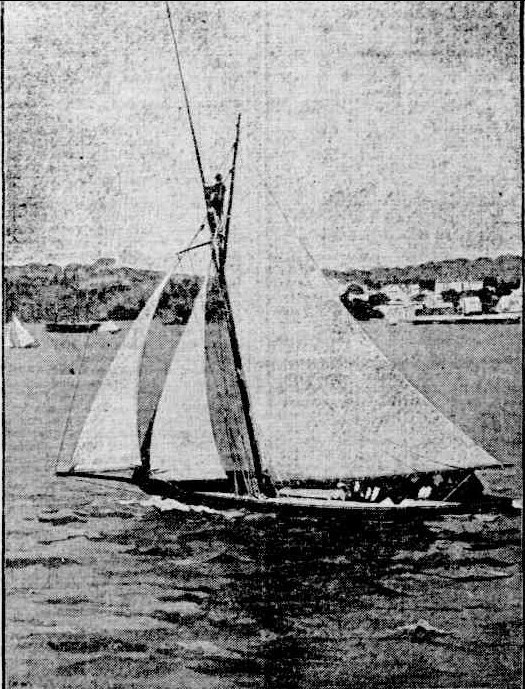
The Australian.
THE LAST DAYS OF THE OLD 24-FOOTERS
The day of the 24-footer of the good old style, the kind of boat that was left in the water for a couple of weeks at a time, and hauled up and treated to a coat of tar and turps on the bottom just before a race, was drawing to close with the seventies. And the varnished cedar racer with gold stripe and 'd— n the expense' outfit soon supplanted her. Mr S.H. Hyam’s flyer, the Lottie, built by Donnelly; the Carlotta, same owner, same builder; the Deronda, Dreamland, and the Aileen, all three by George Ellis; the Duke, by Dunn; the Victor, by Donnelly, and a number of others gave us some splendid racing, but these boats never did the cruising which was the feature of the earlier boats careers.
The Carlotta defeated the Lottie (Mr. Robert Hoodie) in a race to a boat moored off Barrenjoey and back. The sea was calm and the breeze light, and the boats sailed under their harbor racing sails so the race was no test of their sea-going capabilities. All subsequent races for this class were over inside courses, and it was generally acknowledged that the new boats were best suited for the smooth waters of the harbor. The Aileen was purchased by a Melbourne man, and, whether the water in Hobson’s Bay did not suit her so well, or she was not handled as she had been, in Port Jackson, she did not uphold her reputation in her new home. Another crop of 24-footers made an appearance, and for some years such names as the Ida, the Volunteer, the Lady Duff, the Young Harry, and the Willis, were familiar in the races for 24-footers, but the class was doomed, and so strange a thing as a regatta programme without a race on it for 24-footers at last appeared.
(To Be Continued)
The Adelphi (Coryphene's Sister).
The Australian.PORT JACKSON'S PLEASURE FLEETS. (1907, November 2).Evening News (Sydney, NSW : 1869 - 1931), p. 13. Retrieved from http://nla.gov.au/nla.news-article113893525
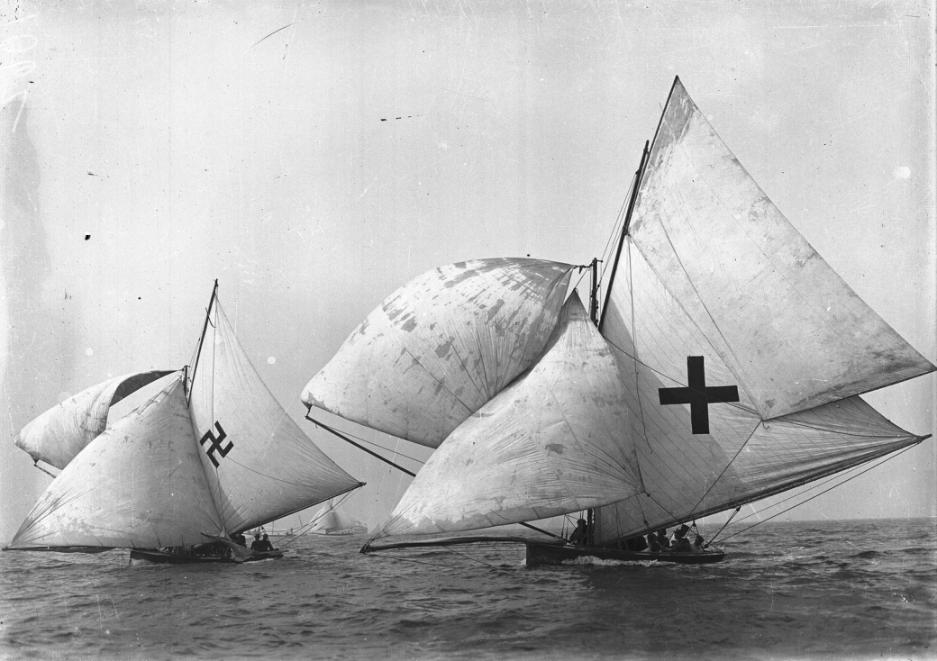
Extras:
Sailing Match.-Our little town of Newcastle was much enlivened by an interesting Sailing Match, which came off on Friday, the 13th instant. The distance run, was three times round the upper and lower Buoys, by the under mentioned boats :
"Arethusa," owner ........ A. W. Scott, Esq., "Cripple" owner ....Capt. R.T. Furlong, "Enchantress," ...owner. Mr. James Hannel.
At about 3, p. m., blowing fresh from the WNW, with a strong ebb tide running, the signal was made for the start, when the "Arethusa" got considerably the lead; however this position she did not hold long, for the "Cripple" came staggering along in her wake, and passed ere she rounded the second Buoy-immediately afterwards she missed stays, and got on shore. The race was now contested between the " Enchantress" and the " Cripple," and became very interesting as the " Enchantress" was much the favorite on starting. After a well contested run, the "Cripple" weathered the Buoy the third time, triumphantly winning the race. I understand the knowing ones were taken in. Newcastle Correspondent. The Theatre. (1838, July 19). The Sydney Gazette and New South Wales Advertiser (NSW : 1803 - 1842), p. 2. Retrieved from http://nla.gov.au/nla.news-article2537738
SAILING MATCH.-The sailing match between the Dolphin, Sea Belle, and Little Mike, came off on Monday, and was won by the Sea Belle. The race was for a sweepstakes of £10 each boat. SPORTING EVENTS. (1853, December 31). Illustrated Sydney News (NSW : 1853 - 1872), p. 3. Retrieved from http://nla.gov.au/nla.news-article63613831
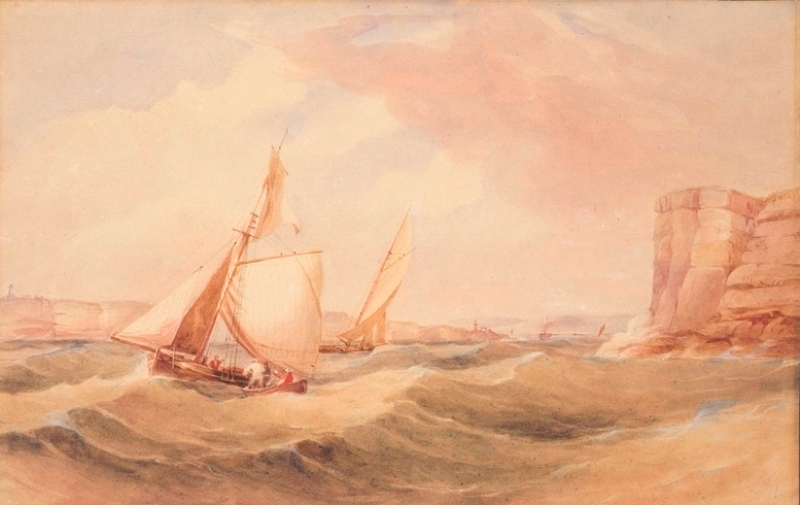
Coasters off North Head [Sydney] / watercolour by Frederick Garling, 1806-1873, Image No.: a128210, ca. 1855-60, courtesy State Library of NSW.
YACHTSMEN'S FRIEND.
THE LATE MRS. MORRIS.
Mrs. Mary Ann Morris, better known to Sydney yachtsmen as "Sally" or "Peggy," died on Monday last at her home at the Basin, Broken Bay, where she had resided for the past 63 years. Her death will be regretted by the yachting fraternity of Sydney, as her hut was a port of call for yachtsmen, when visiting Broken Bay, and they obtained from her supplies of fresh milk and eggs.
Mrs. Morris was the wife of the late Dicey Morris, and, prior to 1867, resided with her husband at Balmoral Beach. About that time her husband sold wood to Admiral Hornby's Flying Squadron during its visit to Sydney, and, with the money thus made, he built the hut at the Basin, Broken Bay, in which Mrs. Morris lived. The couple went to live in this hut at the Basin In 1868, and the husband engaged in fishing there. He did not live long after settling at Broken Bay, and his boat was acquired by a fisherman named Sam Strongman, who also lived at the Basin.
Mrs. Morris kept a few cows and fowls, and was always ready to supply visiting yachtsmen with milk and eggs. She also often baked a very welcome damper for them. She adopted three lads at different times, one of whom was with her up to the time of her death. She possessed a good collection of yachting pictures, and recognised every yacht as it dropped anchor In the Basin. Her memory for faces was also very good, and she never forgot the owner of a yacht which had visited the Basin.
She was known to many as "Peggy," while to others she was better known as "Sally." Amongst the oldest members of the yachting fraternity who were well acquainted with Mrs. Morris were the late Mr. H. C. Dangar, the late Mr. James Milson, the late Mr. Grafton Ross, the late Mr. Jack Want, and the late Sir James Fairfax and their various successors, including Mr. F. J. Jackson, who owned the property at the back of the reservation which was subsequently resumed by the Kuringgai Chase Trust.YACHTSMEN'S FRIEND. (1921, June 9). The Sydney Morning Herald (NSW : 1842 - 1954), p. 9. Retrieved fromhttp://nla.gov.au/nla.news-article15960831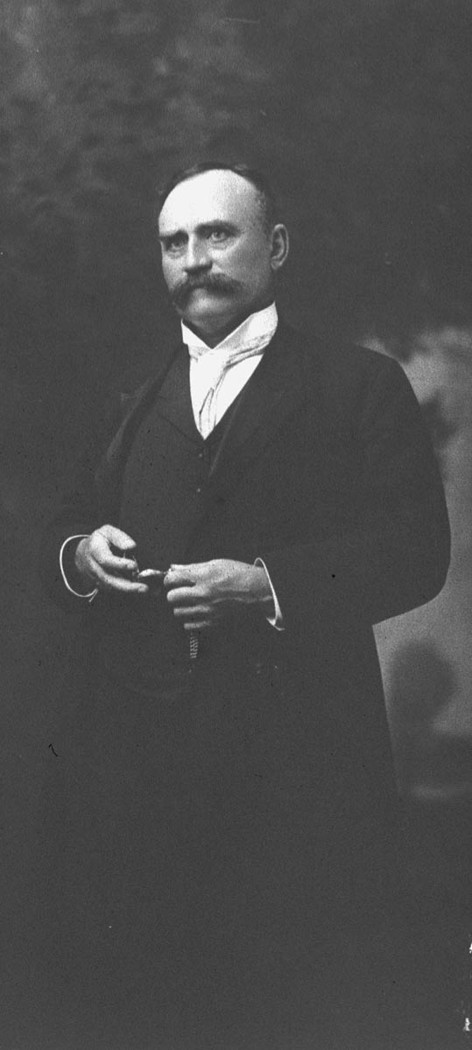 John (Jack) Want
John (Jack) Want
STORY OF THE LATE MR. WANT.HOW HE SUPRISED A SHIPMASTER.-
A story of the late Mr. J. H. Want which serves excellently to illustrate his nature as a sportsman and fearless yachtsman, is told by a gentleman well-known in Sydney legal circles.
''I was travelling up from the Bluff (N.Z.) to Melbourne once,' he said, 'and our steamer ran through some very heavy weather. Our boat, I remember; took in a tremendous lot of water. When the blow had moderated a bit, I was chatting with the shipmaster, and the conversation was upon the subject of the weather.Presently the captain said. 'Do you know a man named Jack Want, in Sydney?' - -'I said that I did, and asked why he mentioned him. ''He replied that we had some great yachtsmen in Sydney, and that Want was one ofthem. Then he went on to say that on a trip across, a little while previously, he had met similar weather to that we had just passed through. As it was clearing up a bit, the look-out man made out what appeared to be a fishing boat in distress. Evidently it had been blown out to sea, for it was quite a hundred miles from land. We bore down on the boat. When we got fairly close I found that it was a yacht, hove-to. Finding her in such an extraordinary position, I signalled her, ‘Do you' want anything?' '' The answer surprised me a bit. He signalled. 'All right, run short of soda-water.' ''It was then,' added the captain, 'blowing hard enough to blow the yacht out of the water. However, I left him, but I was curious to know who he was. When I got to Melbourne, I found that the only yachtsman out in those waters was Mr. Jack Want, of Sydney; who had been down the coast for a yachting trip. It turned out that he had been caught in the storm, and had just hove-to till it blew over.' A YACHTING INCIDENT. (1905, November 22). Evening News(Sydney, NSW : 1869 - 1931), p. 5. Retrieved from http://nla.gov.au/nla.news-article113280827
Photo at right: J. H. Want, Government Printing Office 1 – 11612, courtesy State Library of NSW.
" Jack'' Want.
OF the Attorney-General a contemporary says : " Attorney-General Jack Want is not particular about dress. As seen in the street daily, a stranger would take him for a bushman. His necktie and collar are disarranged, and his face and hands are always as brown and rough as a blacksmith's. Jack can turn his hand to anything. In his day he has turned an honest penny by coal mining, fencing, and shearing. He is also a first class whip.
While Sir Frederick Darley was on circuit years ago, Jack Want came from the coal pit, jumped on the box seat of the coach, and took the reins from the driver. He cracked the whip and inspired the horses with new life and the passengers with terror. Judge Darley protested and insisted in vain that the hired driver should take control, but he soon realised that the stranger could drive, and presently he overheard his name, and guessed he was a son of his old friend Mr. Want. When they arrived at their destination Judge Darley invited the coal miner to dine with him and gave him some advice, with the result that Jack is now Attorney-General of New South Wales. "Jack" Want. (1898, April 6). The Muswellbrook Chronicle (NSW : 1898 - 1955), p. 2. Retrieved from http://nla.gov.au/nla.news-article107013819
"jack" want. For Mr Want, who died last week at the comparatively early ago of 59, there has been nothing but warm commendation. Even the Courts suspended operations to take part in the funeral. Until recently he was a picture of health and strength. But his light went out suddenly, almost without warning. A born fighter, he hit hard, both as a pleader and a politician. But he made surprisingly few enemies. For one thing, the sting of personal animosity was conspicuously absent from his composition. He fought for a cause or for a client, but seldom or never with the direct object of humiliating an opponent. If you happened to be in the way so much the worse for you. He would go over you as a matter of course. Still you felt that if anyone else had been in the way it would have been much the same. It was because "you happened to be there" that the catastrophe happened, not because of any animosity on the part of the gifted " King's Counsel." Peace to his ashes. "JACK" WANT. (1905, December 2). Nepean Times (Penrith, NSW : 1882 - 1962), p. 7. Retrieved from http://nla.gov.au/nla.news-article100956106
THE ABANDONED YACHT MIGNONETTE.
The yacht Mignonette, which was abandoned on the voyage to Sydney, belonged to Mr. John Henry Want, of Sydney, and was swamped by a heavy sea. The boat containing the survivors drifted for 24 days, having only a small quantity of provisions and no water aboard. The survivors were picked up by the barque Montezinna, Captain Andrew, and taken to Falmouth. THE ABANDONED YACHT MIGNONETTE. (1884, September 10). The Mercury (Hobart, Tas. : 1860 - 1954), p. 2. Retrieved from http://nla.gov.au/nla.news-article9092984
MR. J. H. WANT DEAD.
The death occurred yesterday of the Hon. John Henry Want, K.C., M.L.C., an event which had been expected for some days. The deceased gentleman was a native of Sydney, and was aged 59. He read for the bar with Sir Frederick Darley. Mr. C. E. Pilcher, and Mr. Justice O'Connor. His career at the bar was a brilliant one, and in politics he held a distinguished position. He represented both Gundagai and Paddington in the State Assembly and several times held the Attorney Generalship. MR. J. H. WANT DEAD. (1905, November 23). Wellington Times (NSW : 1899 - 1954), p. 4. Retrieved from http://nla.gov.au/nla.news-article137917593
Death of Mr. J. H. Want,
The Hon. Johu Henry Want, K.C, M.L.C, died at his residence, Darlinghurst road, on Wednesday morning after a short and painful illness. A little while ago Mr. Want was suffering from a throat affection, from which he recovered; but almost immediately after was found to be suffering from appendicitis. Owing to his heart being in a weak stale, the medical men found it impossible to attempt an operation. Dropsy supervened; aud, though the patient was kept alive for a few days by injections of oxygen, all hope of a rally was abandoned. Death of Mr. J. H. Want, K.C. (1905, November 24). Narandera Argus and Riverina Advertiser (NSW : 1893 - 1953), p. 2. Retrieved fromhttp://nla.gov.au/nla.news-article130443368
John Henry Want (1846-1905), barrister and politician, was born on 4 May 1846 at Glebe, Sydney, fourth son of nine children of Randolph John Want, solicitor, and his wife Hariette, née Lister. Educated at Rev. W. H. Savigny's Collegiate School, Cooks River, and Sydney Grammar School, Jack reputedly spent some time at Caen, France. Entering Randolph's office, he became dissatisfied with the monotony of legal practice and worked on the land in Queensland and at a mine in which his father had an interest at Lithgow, New South Wales. Attracted back to the law, Want read in the chambers of (Sir) Frederick Darley and was admitted to the Bar on 13 November 1869. At St John's Anglican Church, Darlinghurst, on 20 December 1870 he married Mary Selina Augusta Prince; they were divorced in 1884.
On 25 November 1898 at St Stephen's Anglican Church, Kurrajong, Want had married Nina Ventry, née Everest, a 42-year-old widow with two daughters. He defended Dean Denis O'Haranin Arthur Coningham's divorce case in 1900-01 and later defended the solicitor T. M. Slattery. In 1904-05 Want opposed Sir Josiah Symon's attempt to move the High Court of Australia's principal seat to Melbourne.
Vigorous and robust, Want threw 'the same energy into his amusements as into his serious avocations'.
Like his father, he was a member of Royal Sydney Yacht Squadron and enjoyed sailing down to Hobart or fishing on Port Hacking, dressed like 'a pirate bold'. He was a trustee of (Royal) National Park and a member of the Board of Fisheries, in which capacity he did much to develop and to protect the fisheries of the colonies, as well as advocating the introduction of trout to inland waters. A generous foe and a loyal friend, he was a member of the Union Club, a patron of the turf, a motorist and an inveterate traveller. He emerged as an authority on shipping matters: 'nobody knew more about the rules of navigation, or the harbour regulations'. Frequently appearing as a junior with William Bede Dalley in 'heavy cases', Want was appointed a Queen's Counsel in 1887, but declined elevation to judicial office. He was, in his own words, much attracted by 'the active life and excitement of my profession'.
Paul Finn, 'Want, John Henry (1846–1905)', Australian Dictionary of Biography, National Centre of Biography, Australian National University, http://adb.anu.edu.au/biography/want-john-henry-8979/text15801, published in hardcopy 1990
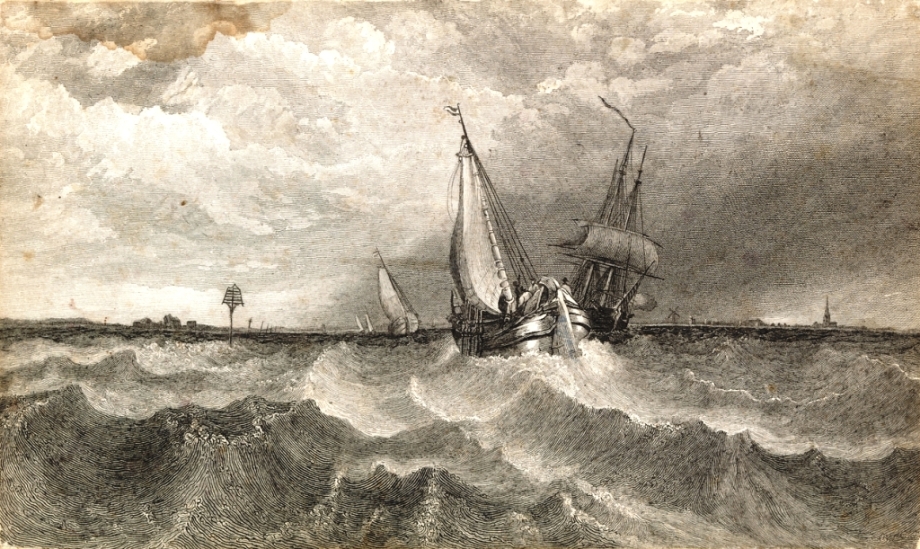
Point Nepean (Victoria), from Volume 02: Sketchbook XXIII. No. 5 Australian. Australia. May, 1855 by Eugene von Guerard, Image No.: a3626003, courtesy State Library of NSW.
YACHTSMAN AND SPORTSMAN
Mr. Frederick Jackson Passes
Mr. Frederick J. Jackson, who died recently at his residence, Darling Point, linked the past generation of yachtsmen with the present. In the days of the old deep keelers, Mr. Jackson was one of the most enthusiastic and successful sailing men in New South Wales, and more than held his own at the tiller against such redoubtable yachtsmen as Dr. Mackellar, Mr. Alfred Milson, Mr. Edward Knox and the late Mr. Alfred Fairfax, Dr. Milford, Mr. Jack Want and Mr. Prosper Williams. Mr. Jackson was one of the founders of the Royal Prince Alfred Yacht Club, and at the time of his death was the oldest member of the Royal Sydney Yacht Squadron. As far back as the year 1867 he won the yacht race at the Anniversary Regatta with Gitana, an eight-tonner which had been a large half-decker. With this yacht he won numerous races. Later on Mr. Jackson owned the famous yacht Mischief, in which he had years before sailed In English waters. Subsequently he purchased the Ione, and after racing her with success sold her to Mr. Alfred Milson. His last yacht was the well known and stately Violet, which was built for him in 1876 by Langford to the design of D. Hatcher, of Southhampton. Violet, in her early days, was the winner of many races- with her owner at the tiller. In his later years of yachting, however, Mr. Jackson avoided racing, contenting himself with cruising, particularly along the coast, and often sailing to Broken Bay, where he possessed a residence and property. In the '70'8, '80's and '90's Mr. Jackson was one of the inner circle of local yachtsmen, and took a leading part in the control of the sport. Of him it may be said that he was thorough—both as a yachtsman and a gentleman. PERSONALS IN SPORT . (1923, June 6). Referee (Sydney, NSW : 1886 - 1939), p. 1. Retrieved from http://nla.gov.au/nla.news-article128114326
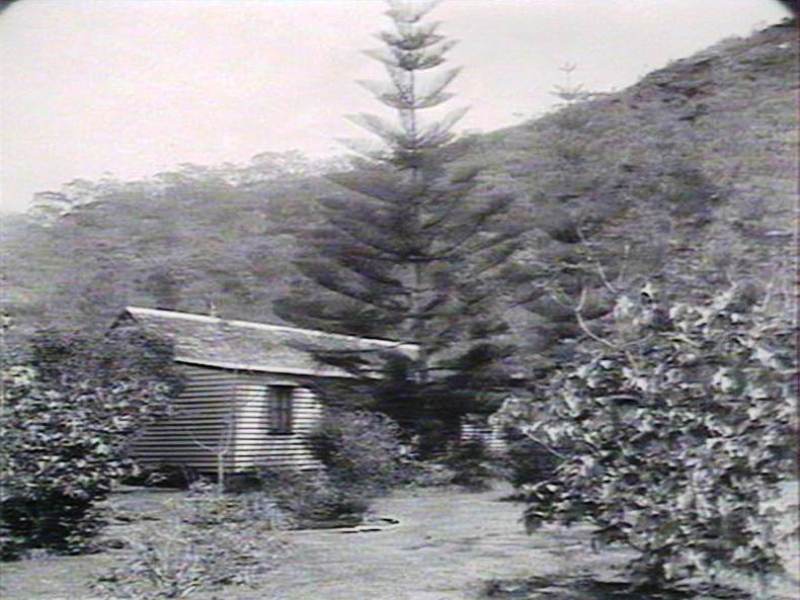
Topham. F.W. Jackson's Cottage at The Basin, Government Printing Office 1 - 08825, courtesy State Library of NSW.
MORE ABOUT A VETERAN YACHTSMAN
The Late Mr. Frederick J. Jackson. His Early Impressions of'( Sydney
Seventy-two years in business was Mr. Jackson's record, excepting for a painful parenthesis last year, due to a tram accident. He came to Sydney 64 years ago, and his reminiscences connect the London of Charles Dickens with the early days of Sydney. In London as a Junior clerk in an insurance office, he frequently saw on his business errands Queen Victoria and the Prince Consort during the Crimean War, and Empress Eugenie, on her visits to the English Court before the Franco-German War had ended her regal career. In those days, as in the latest, the Interest of his leisure hours was centred in boat-building and sailing. He knew the Thames from quiet Kingston to the troubled tidal-waters of the estuary, and In this neighborhood he lost his first boat and gained some unexpected experience from a bibulous sailor engaged to Instruct him.
FIRST PEEP AT SYDNEY.
Of his first morning in New South Wales Mr. Jackson had a keen recollection: 'I was 'Staying at a hotel near St. Phillip's Church,' he related. 'After a restless night I rose early, anxious to see what Sydney was like, and what prospects it offered externally for business. I walked down Jamieson-street Into George-street, and turned towards the Quay. In those days it was Chinese quarters. The houses were for the most part mere shanties, dismal looking and squalid. They say that 'first impressions go a long way!' My first Impressions had a most depressing effect on my spirits.' : I could see no prospects of establishing a branch of the insurance company I represented, and had a strong inclination to find a good ship going home, and embark at once.
A YACHTING VISION.
However, I continued my walk, crossed the Domain and sat down near Mrs. Macquarie's Chair to contemplate the waters of the Harbor. What a vision for a yachtsman! A seven-ton yacht was riding at her moorings, and a great desire seized me to sail a boat like that across the dancing waters and explore the distant bay's. As such possibilities occurred to me I forgot my wish to return to England, at least for the present. On my return to the hotel I learned that the owner of that fascinating little craft was about to leave Australia, and was offering it for sale. Eventually I found myself the happy owner, and I fully believe that yachting has saved my life.' There Is nothing better to rest and refresh a busy man. The change of thought, the glorious salt air, and the companionship of men united in a love of Nature and adventure makes yachting the ideal sport. During my earlier years in Australia I had a serious illness, some lung trouble apparently, and the doctors, Melbourne doctors, by the way, forecasted my decease in a fortnight. That was over sixty years ago!' Mr. Jackson was the only surviving founder of the Royal Sydney Yacht Squadron, and the 'father' of the Royal Prince Alfred Yacht Club.' PERSONALS IN SPORT. (1923, June 13). Referee (Sydney, NSW : 1886 - 1939), p. 1. Retrieved from http://nla.gov.au/nla.news-article128116707
OLD-TIME CORINTHIANS.
FREDERICK J. JACKSON.
(By 'CORINTHIAN.')
We of the present day are apt to forget what we owe to the pioneers of yachting in these waters. The difficulties of all descriptions which arose only to be overcome, and the benefit to sport thereby, must have been enormous. Such enterprise In the push by the pioneers has Placed the pastime of sailing generally on a sound footing. For Instance, in last Saturday's sailing events there were 93 entries, and this
fleet probably carried crews numbering close on 600. How many of those participants ever give a thought to those who made it possible for them to compete under well-drawn-up rules and conditions, for the various prizes that were competed for? It Is well at times to take a look back and honor those who 'blazed the track.' It is safe to say that we have among us the oldest Corinthian south of the line, in the person of Mr. F. J. Jackson, who, since 1881, has held the position of secretary of the Victoria Insurance Company, and is esteemed among yachting men and commercial men alike. Before reaching these shores Mr. Jackson, who is a Londoner by birth, but by residence and adoption can now be called an Australian, got his baptism at the hands of Father Neptune. This occurred when ho was thirteen years of age. At that time he and his brother purchased a 9-ton yawl. Neither of the budding Corinthians thoroughly understood the management of their property, and they were compelled to employ a professional to give Instruction. This Individual took them out Ina howling gale, and, after being out ail night, landed them on the Essex shore at dusk on the following evening. Shortly afterwards the gale Increased, and their mentor, who had been left in charge, forsaking the shrine of Neptune for that of Bacchus, allowed her to drag her anchors, and she, in consequence, become a total wreck. The unfortunate occurrence did not kill Mr. Jackson's love of the sea though his brother declined to join In another such venture. Within six months he purchased the Hero, of nine tons, and during his ownership of this craft familiarised himself with ll the ways of the sea. He next bought Ellen, then Brilliant, Bantam, Kate, and lastly the 11-tonner Traveller. The chosen cruising ground was the Thames estuary and Its upper reaches. Mr. Jackson was cruising off the north of Foreland when the Australian steamer Royal Charter was wrecked close by in a heavy gale. He himself only managed to gain safety after a hard battle with the elements.
On arrival at Sydney, at the age of twenty three, he was disappointed to fin that there was no yacht club In existence, the Sydney Club having become extinct. Within six months of his arrival he purchased Gitana, a 7-tonner, and won several prizes with her in subsequent regattas. Gitana was run Into by a steamer, and then was afterwards lengthened, growing in size to 10 tons. After dispoing of her he bought Mischief, which was transported from the Old Land by the late Mr. James Milson in 1865. Mr. Jackson was not unacquainted with Mischief having enjoyed a sail in her before his departure from England. He also came across a 9-tonner called Julia which he had been in process of building at Samuel Pepy’s Yards, Blackwall, London. Mischief was raced with varying success.
It was at this time that the Royal Sydney Yacht Squadron arose from the ashes of the Sydney Club. Mr. Jackson was one of the original members of that Institution, and the only one now alive that has owned a credit throughout his connection with it. He was a member of the first committee, and continued in that capacity for a number of years, finally retiring. After parting with Mischief, Mr. Jackson sailed Ione, previously the property of Mr. Grafton Ross, and won a number of races with her. In 1877 Mr. Jackson sent to Hatcher, of Southampton, who was famed as a designer at that time, for the plans of a 10-tonner. As a result the famous Violet was built locally by the late W. Langford. Her success was phenomenal, being finally so heavily handicapped that success was impossible. She Is credited with being the last yachts designed by Hatcher, and when Mr. Jackson sold her he closed his racing career, having won in various boats owned by him in England and Australia about 15 prizes. Since those days be has owned various craft, both motor and steam, Valeria being of the latter. Mr. Jackson was for twenty-three years associated with the local Naval Brigade, during the time the old Wolverine, afterwards broken up at Auckland. N.Z., was at the corps disposal for sea training. He holds a coast masters certificate by examination. The Royal Prince Alfred Yacht Club conferred Life membership upon Mr. Jackson In recognition of his Invaluable services to yachting. Mr. Jackson has lived happily lo see the waters of Port Jackson studded with craft of all descriptions— In contrast to the small number of white wings that ploughed IU depths when the world was rather younger. OLD-TIE CORINTHIANS. (1913, November 8). Saturday Referee and the Arrow (Sydney, NSW : 1912 - 1916), p. 3 Supplement: ISSUED AS A SUPPLEMENT WITH THE SATURDAY REFEREE. Retrieved fromhttp://nla.gov.au/nla.news-article117417916
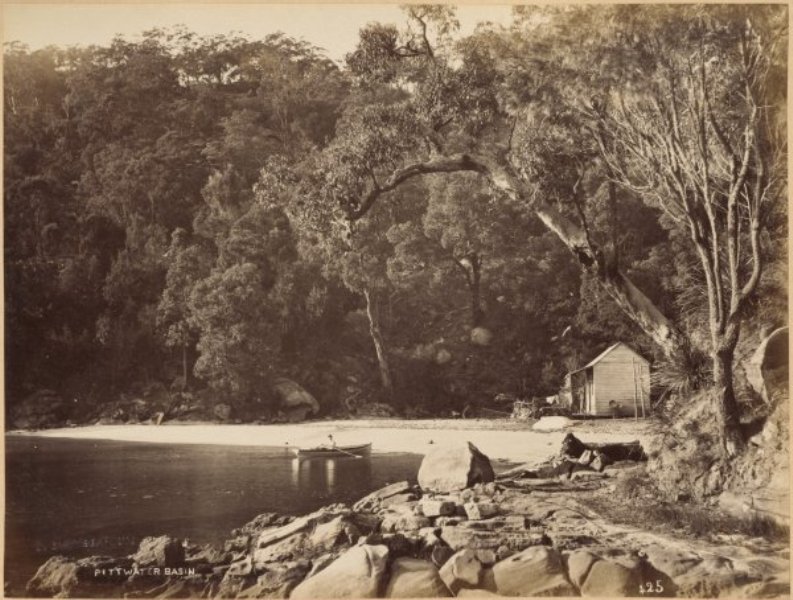
Pittwater Basin, New South Wales by Charles Bayliss 1850-1897, circa 188?. Courtesy National Library of Australia, Image No.: nla.pic-vn4197942.
YACHTING- NOTES.
Mr. J. H. Want has parted with his yacht the Daphne and has given W. Langford, of North Shore, an order for a ten-tonner. The new craft will be commenced at once, and she is to have four inches more beam than the Violet, will be four feet shorter, and she is supposed to embrace very great weatherly qualities, by being two feet deeper. The model shows a line entrance, with the body of the midship section carried low down for lead ballast, and no load will be placed in the keel. The now dipper will be ready for delivery next June.
We understand that Dr. M'Kellar will shortly have constructed a new ten-ton yacht, designed by the celebrated Clyde builder, Fyfe; Mr. Beattie, it is reported, is to build the new boat.
A beautifully modelled yacht of seven tons was launched by W. Langford, at his new building place, North Shore, on Thursday morning last, and the launch proved in every way a success. The yacht, has been built for Mr. Edwin Norris, solicitor, of Townsville, and she will proceed to her destination on the deck of the steamer Tiotorla, on Saturday. The Maud, as she has been named, after the owner’s daughter, measures 26ft 6in on the keel, and 30ft overall, with a beam of 8ft 6in, and fitted with a centreboard. Langford appears to have devoted extreme care in the construction of the craft ; the kauri planking rims the extreme length of the yacht, thus it is free from butts. The keel and timbers are of colonial hardwood, and the fittings are of a first-class description. The outfit is a very complete one comprising two suits of well cut sails, by Carter: and two sets of spars, one for working and one for racing. The Maud is fitted up with copper tanks, so that in case of shipping any large quantity of water, there is no danger of her sinking. YACHTING NOTES. (1878, January 19). Australian Town and Country Journal (Sydney, NSW : 1870 - 1907), p. 36. Retrieved from http://nla.gov.au/nla.news-article70611930
SHOCKING AND FATAL ACCIDENT - Death of Mr. William Langford.
About a quarter past 8 o'clock yesterday morning Mr William Langford, the well-known yacht-builder, of Northshore, met his death in a manner as unexpected as it was painful. It seems that he was accustomed to have the crooks used in boats cut at Billvard's Bonemills, at Pyrmont, and went to that establishment to superintend the cutting. The man who was assisting him, Robert Berry, had got through one of the crooks as far as the bend, and, there being some difficulty in raising it so as to cut the other part, Mr Langford jumped on to the bench to ease the timber for Berry. He placed his right foot too near the circular saw, which in an instant cut through his boot took of his heel, and dragged him onto the saw. As he fell the saw passed through his right leg severed it just above the knee, and threw it a considerable distance to the lower end of the bench. In his further descent Mr. Langford's left arm came in contact with the saw, and a large strip of flesh was cut off down to the bone. As soon as possible he was taken to the Infirmary, but he died before he reached that institution.
To write of William Langford is to recall many pleasant memories in Australian aquatic history. His name has been connected with the yacht and boat building of Port Jackson for very many years, and his many well-fashioned models have won on countless occasions. It may be safely asserted that there was not a builder who better understood his business, or was more widely respected in the trade than the subject of this notice. Those to whom he was personally known need not to be reminded of his many good qualities. He was a native of Sydney. He was born in the year 1832, and was therefore 48 years of age. A widow and large family mourn his untimely end. The age of the eldest of the children is 18 years. Langford, early in life, took up his abode at Miller's Point, and it will be seen further on that his long and successful career forms in itself an extensive chapter in aquatic history. William Langford's boating premises are situated on the western side of Blue's Point, North Shore, looking on to Berry's Bay. He gained much of his building knowledge while following the trade of shipwright in his youth. For the last 27 years he has been engaged in yacht and other boat building.
Up to four years ago he was in partnership with his brother Thomas, at Miller's Point, who has since died. William devoted his attention almost entirely to the deep-keeled yachting branch of the trade. Those whose memory carry them back to the early days of yachting in Port Jackson will remember the Sea Belle, Fawn, Daisy, Dora, Lubra, and Calypso, which were built under the supervision of William Langford. Later on, when deep keel boats became fashionable, that little wonder, the Nereid, was built for Messrs. Fairfax and Lassetter. Since that period the number and names of vessels that Langford has built are very numerous. He has built about sixteen vessels for the pearl shell fisheries in Torres Straits. Among them was the schooner Two Brothers, and the centreboard yacht Maude, for Queensland.
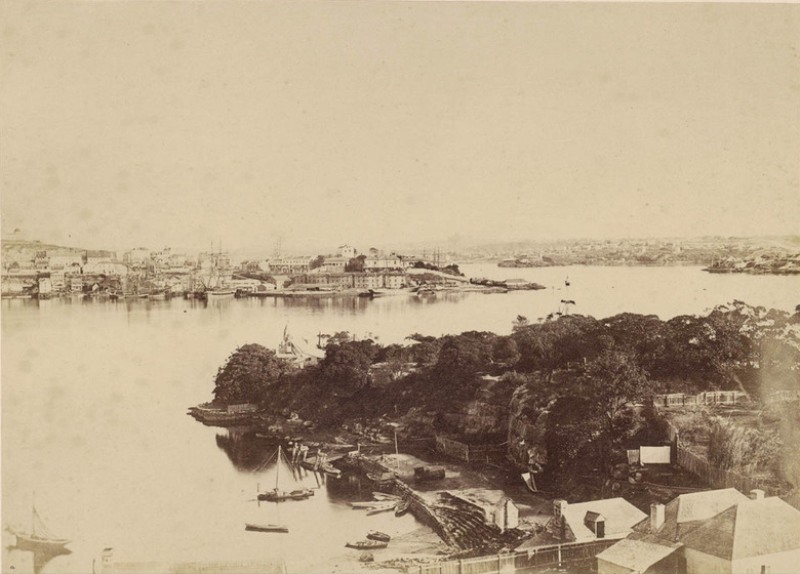
"Millers Point" from North Shore, undated [1870s ?], Image No.: a089933, courtesy State Library of NSW.
Latterly he constructed the steam watertank Gleaner, for Mr. Fenwick, and the framework of an unfinished steam launch occupies his building shed. All the pearl shell boats he turned out gave great satisfaction, both for speed and weatherly qualities. It was, however, in the yachting line that Langford excelled as a builder, and it is not going too far to say that he died a man who has done more than any other in his vocation to render Port Jackson famous as the leading yachting centre of the Southern Seas. After the Nereid, he framed the Ione, which had a wonderful career of success, under the ownership of Mr J. F. Jackson. Then followed the little Orpheus; and next in turn came Langford's great chef d'ouvre the Magic, 28 tons to the order of Mr Alfred Fairfax. The Magic's brilliant achievements on the water are too numerous to be dealt with in a notice of this kind, and she is apparently destined to long survive her builder in her career of success, under the colours of Mr James R. Fairfax. The next yacht launched was the Pleiades, 10 tons for Messrs. T. and W. Knox, and her fame as a racer shows out brilliantly in yachting history. The Meteor followed in the wake of the Pleiades, a craft of about the same measurement, but fuller lines She was built for Mr S. Hordern and is at present owned by Mr. James R. Fairfax. These yachts were all designed by Langford, and they have proved not only very fast, but remarkably durable.
Langford's next task was to construct a 10-ton yacht for Mr. J. F. Jackson, and designed by the late Dan Hatcher, who is reputed to have turned out the best yachts in England of the 10-tons and under class. The Violet, as the new boat was called, defeated everything of her size that she ran against, and gave us the first practical demonstration of the advantage of carrying the ballast on the keel. In Langford's next model, the Mabel, now owned by Mr. Love, he took a leaf out of the English builders' book, and clapped two and a half tons of metal on the keel. Mabel has been a lucky prize winner, and her owner may justly be proud of her. Mr J. H. Want, Commodore of the Prince Alfred Yacht Club, then favoured Langford with an order for the fastest 10-tonner he could build, but in this vessel Langford discarded the lead keel, believing that by placing the ballast well down on the inside of the yacht it would prove as effective. The Guinivere, however, did not come up to expectations, so the builder took her in hand again last year, removed a lot of the dead wood from her heel, and rounded off her stem The alterations had the desired effect, and Mr Want possesses in the Guinivere one of the fastest yachts in our waters. The Oithona,15 tons, on lines by a Scotch architect, for Dr. Mackellar, was the last beautiful piece of yachting work from this builder's yards. It may be said of William Langford in brief, that he attained the highest reputation as a yacht-builder, he has left a good name behind at the end of a life steadily devoted to business, and passed to the grave amid the regret of a large part of the community, especially of those who take an interest in aquatics. SHOCKING AND FATAL ACCIDENT. (1881, February 19). The Sydney Morning Herald (NSW : 1842 - 1954), p. 3. Retrieved from http://nla.gov.au/nla.news-article13479341
FOR SALE or Charter, the Clipper Schooner JENNY B. For particulars apply 78, Pitt-street, Sydney.
FOR SALE, the half-decked centreboard Boat-B-1 TRITON, wi til pleasure and racing sails complete. J.H.M'KINLA Y, Box I'.tQ, G. P. O._
FOR SALE, 24-feet half-decked boat, CORYPHENE, with dingy, tel tt, &c. One of the most comfortable camping boats in the harbour. Apply WALTER REEKS, N.A., 139, Pitt street._ .
FOR SALE, fife fast-sailing well-known Coasting Ketch ELIZA-, 7 tons, in good condition, ready for sea, with new copper, and in fast sailing trim. Apply C. B. BOND, 94, Sussex-street.
For SALE, s..r GLENELG, having just received a thorough overhaul. For particulars, apply PORT JA.CKSON STEAMSHIP COMPANY, Circular Quay.
FOR SALE, .the teak-built Ship, SHANNON, 1292JO tons register, now discharging at Woolloomooloo Bay. For full particulars apply to Captain Smith, on board, or -LORIMER, ROME, and CO.,
Agents. 84, O'Connell-street
FOR SALE, the well and favourably known Steamships RINGAROOMA and ARAWATA, 100 All dimensions, 245feet 4 inches x 30 feet 1 inch X 21 feet 9' inches ; tonnage, 1098tons gross, 623 tons nc t \ nominal h.p., 300 passenger accommodation for 120 saloon a çei 103 steerage; cargo capacity, 500 tons;(bunkers, 226 tons ; engines compound surface condensing. Both these vessels are in good going order, and have extensive inventories. For price, plans, and all other particulars, apply UNION STEAMSHIP COMPANY, Margaret and Sussex streets.
NEW-VARNISHED (14 and 16 feet) SKIFFS, £7 and 8. Mr. Weir, Moor, Darling-street, Balmain._
NORTH SHORE STEAM FERRY COMPANY, Limited. STEAMERS for SALE. For full particulars, apply to THOMAS SUMMERBELL, Manager.
STEAM LAUNCH Sea Breeze for SALE, first-class order, decked. Full particulars Finlayson, 614, George-st.
STEAM LAUNCH, 42 .toot length, 8 foot beam, 9-h-p., low price. Chits. Bat y and Co., 101, Pitt-street._
STEAM LAUNCH for SALE, built by Rock Davis, nett register, 18 tons; With, and low pressure engines, by Chapman; carries 25 tons: ... and machinery in first-class order. Apply THOS. A. STRICKLAND, 3, O'Connells street.
THE well and favourably known Yacht DORIS for SALE; comment is needless. 181,Liverpool-street. Advertising. (1887, August 6). The Sydney Morning Herald(NSW : 1842 - 1954), p. 22. Retrieved from http://nla.gov.au/nla.news-article28350998
